Untreated Obstructive Sleep Apnea and its Impact on Chronic Diseases
iNAP Sleep discusses the importance of OSA patients finding the right therapy for themselves. iNAP is a treatment that many patients are willing to use long-term, which is paramount to preventing chronic diseases. Additional information can be found at https://www.inapsleep.online/.

Many articles have been written about how untreated Obstructive Sleep Apnea (OSA) leads to the development of life-changing chronic diseases. According to the Center for Disease Control (CDC), 6 in 10 adult Americans live with one chronic disease, while 4 in 10 have two or more. Some of the most common diseases included are Diabetes, Cardiovascular Disease, Kidney Disease, Alzheimer's, Cancer, and Arthritis. These conditions limit activities, work, and function and affect the quality of life and the lives of family members. Lifestyle, nutrition, exercise, genetics, and sleep- all have the potential to impact the development of chronic diseases, which are also the #1 factor of healthcare expenses in the US. We believe that the risks of developing these life-changing conditions could be mitigated if the underlying OSA was treated successfully. Suppose patients were offered an easy-to-use, comfortable sleep therapy that they would be willing to use each night all night long. In that case, it could reduce the risk of developing some of these chronic conditions.
The comorbidities associated with chronic diseases do not improve if they are poorly managed or left untreated. A critical factor in a successful treatment is that patients feel comfortable with the therapy and are motivated to use it. Developing such treatments should be designed with patients' comfort and preferences in mind. Obstructive Sleep Apnea (OSA) affects approximately 54 million Americans. During apnea, there are frequent and extended periods when the patient stops breathing at night. This leads to a reduction in oxygen in the patient's blood, impacting the brain and other vital organs. In addition, awakenings caused by constant microarousals may diminish deep, restorative sleep. Research has shown that this process contributes to the earlier mentioned chronic diseases and comorbidities. Furthermore, excessive daytime sleepiness affects memory, performance at work, quality of relationships, level of stamina, and alertness.
Despite all, we know about the importance of healthy sleep, 80% of patients who are likely to have OSA have not yet been diagnosed or have refused to pursue a diagnostic sleep test. With Home Sleep Testing more readily available, especially during and post-COVID-19, obtaining a sleep test is now easier than ever. During a phone or video call, patients can ask their health care practitioners for an HST or find a sleep specialist online who will prescribe a sleep study and who is also familiar with the newest therapies.
The reasons for low diagnosis rates may be attributed to several factors:
1. Conversations about sleep may not be discussed during scheduled medical or dental appointments,
2. The process to obtain a diagnostic sleep study to be covered by insurance may be inconvenient,
3. There is a stigma associated with the most prevalent treatment: Continuous Positive Air Pressure therapy (CPAP). With CPAP, the machine pumps normal room air through a tube all night long. A long tube attaches to a nasal or full-face mask which is worn over the nose and/or mouth and held on the head by straps. Air blows all night to keep the airway open. Awkward, uncomfortable, complicated to maintain, and commonly disliked by the bed partner, adherence rates for CPAP are known to be ~50%.
At iNAP Sleep, we understand the challenges of both chronic diseases and their impact on untreated OSA. We have developed the latest innovation in OSA therapy that took these factors and removed most of the barriers to treatment. iNAP has no mask and no continuously running noisy pump. It's as small as your cell phone, making it portable and very comfortable. iNAP therapy will provide sleep physicians and sleep apnea patients with a new alternative that is simple, comfortable, patient-preferred, and easy to use- overall, a significant improvement over CPAP.
iNAP Sleep was established in 2011. It has been doing business for 10 years in Southeast Asia, parts of Europe, and Australia and now available in the US.
To learn more about iNAP, including who it helps, how it works, clinical evidence, how to obtain it and get started, please visit www.inapsleep.online
If interested then here is how to get it: How to get iNAP device?
For further information about iNAP Sleep, this can be discovered at https://www.inapsleep.online/

